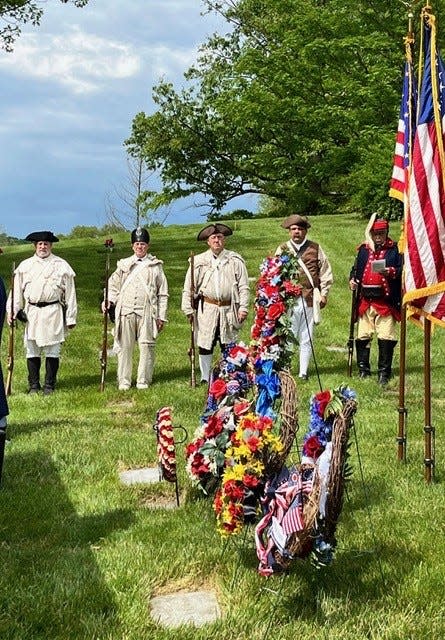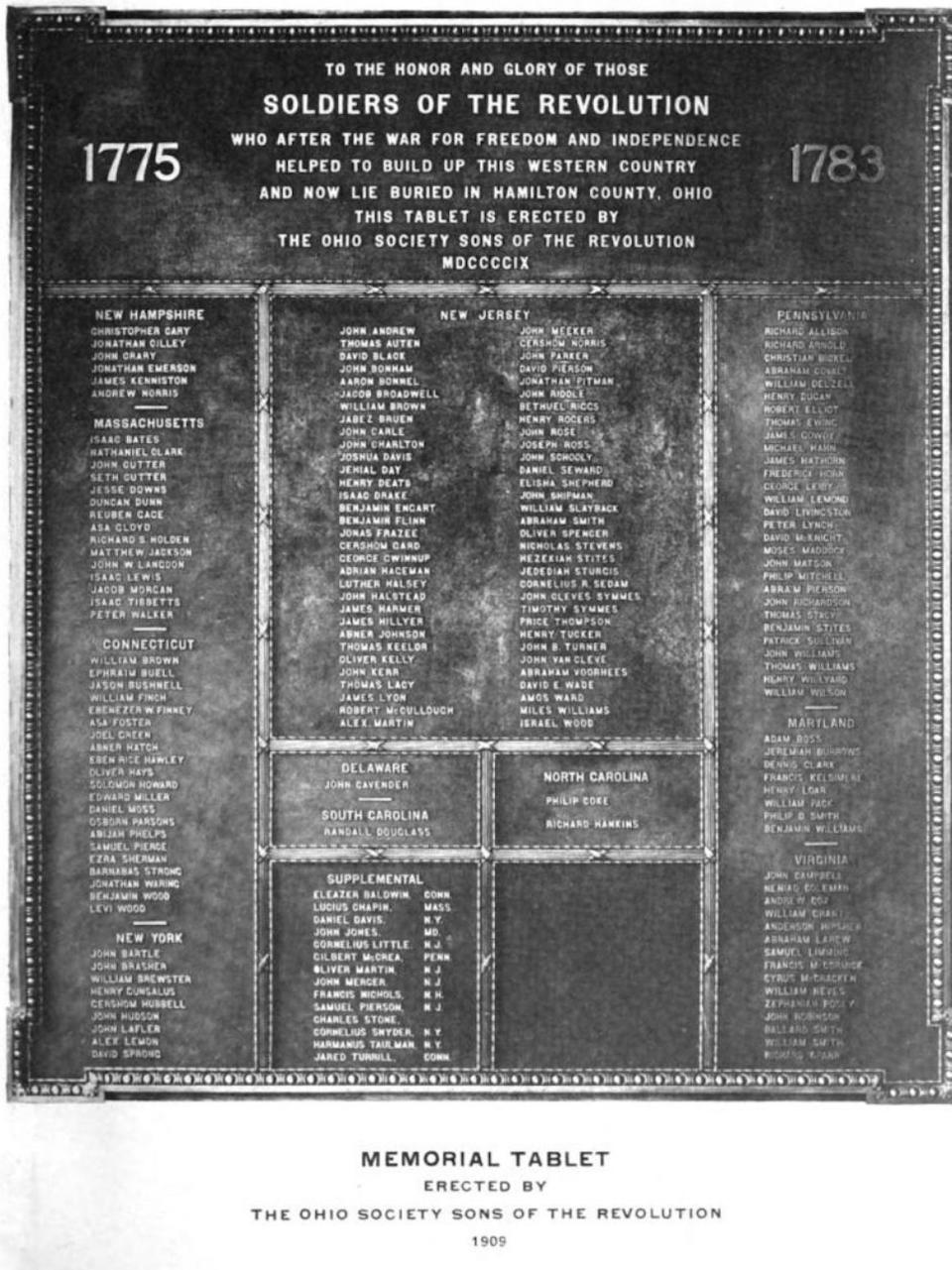‘Buried somewhere in Hamilton County’: Remembering Cincinnati’s Revolutionary War patriots

The Cincinnati Chapter of the Sons of the American Revolution is making sure our Revolutionary War patriots are not forgotten.
Many of them have been, for too long. Their graves were unmarked or covered over and lost. Others were reburied, but there is no record.
On July 4, the Cincinnati SAR will dedicate a Revolutionary War memorial in Washington Park and honor five Continental Army veterans who are buried somewhere in Hamilton County but have no grave markers.

Our History: Before becoming a booming city, Cincinnati was a river town
This is just the latest memorial effort by the local SAR chapter, whose members are direct descendants from people who served during the American Revolution.
When Michael B. Gunn became the chairman of Cincinnati SAR’s Revolutionary Sites and War Graves Committee in 2013, he took on a project of identifying where all the local Revolutionary War veterans were buried.
There’s a lot more than you’d think.
Cincinnati’s early settlers were Revolutionary War veterans
We don’t often consider Cincinnati’s connection to the Revolutionary War. After all, this was the first fully American city, founded in 1788 after the end of the war. Yet many of the early settlers had served in the Continental Army during the war.
John Cleves Symmes – who purchased more than 300,000 acres between the Great Miami and Little Miami rivers, what constitutes most of Hamilton, Butler and Warren counties – had served in the Sussex County, New Jersey, militia and was one of that colony’s delegates to the Confederation Congress.
David Ziegler, Cincinnati’s first mayor, served under Gen. George Washington, was wounded at the Battle of Long Island, suffered through the winter at Valley Forge and was present at Yorktown when Lord Cornwallis surrendered to Washington.
Other former soldiers that moved to Cincinnati died in relative obscurity. Few remember their names. That has been changing as the SAR and other patriotic organizations make efforts to pay tribute to these forgotten patriots.
Plaque in Memorial Hall lists ‘soldiers of the revolution’
Back in 1909, the Ohio Society of the Sons of the Revolution (a different organization than the SAR) placed a bronze tablet in Memorial Hall with the dedication: “To the honor and glory of those soldiers of the revolution who after the war for freedom and independence helped to build up this western country and now lie buried in Hamilton County, Ohio.”

The plaque lists 185 names, grouped by state, from a list gathered in 1895.
“My list shows a lot more than that,” Gunn said. He has compiled 585 names, he said, and has made some additions to existing monuments.
In 2014, the SAR added 25 names to a stone memorial that the Daughters of the American Revolution had erected in Spring Grove Cemetery in 1976. It now lists 60 Revolutionary War veterans buried or memorialized in that cemetery.
The graves of some of the names on the Memorial Hall plaque haven’t been identified, though.
“There are 54 buried somewhere in Hamilton County,” Gunn said. “We don’t know where. But a number of them were buried in what is now Washington Park.”
So the Cincinnati SAR installed a granite marker in Washington Park across the street from Memorial Hall with the same inscription as the plaque, to honor those 54 forgotten patriots.
Why were they buried in Washington Park? To explain, let’s go back to 2014.

Looking for the grave of a Boston Tea Party participant
One of the names added to the stone memorial in Spring Grove was Joshua Wyeth.
At the same time as those additions were made, Tina Wyeth Baker, a descendant of Wyeth’s brother, was trying to locate his grave in Cincinnati.
Wyeth had volunteered at the Battle of Bunker Hill in 1775 and then enlisted in the Continental Army, serving as a private in the Massachusetts Line. Most notably, when he was 15 years old, he had been one of the protestors who dumped tea into Boston Harbor on Dec. 16, 1773, to protest British taxation on the colonies. He and the other Boston Tea Party participants were sworn to secrecy, and none of them talked about their involvement for more than 50 years.
It was Wyeth who broke the silence. Having relocated to Springfield, then Cincinnati, he opened up about what he called “the Boston Tea Party,” and word got around town. Before that, the protest was known as “the Destruction of Tea at Boston Harbor.” Then, Wyeth gave the first first-person account of the Boston Tea Party by one of the participants, which was published in the July 1827 edition of Western Monthly Review, published in Cincinnati by Timothy Flint.

Wyeth died in 1829. There is no record of his burial, but Christopher Smith, a reference librarian at the Cincinnati & Hamilton County Public Library, told The Enquirer in 2014 that Wyeth was likely buried in the Episcopal and Presbyterian burying grounds on 12th Street in Over-the-Rhine.
The city bought the cemetery in 1855 to convert it into Washington Park and advertised in newspapers for families to pay to move the remains of their loved ones to Wesleyan or Spring Grove cemeteries. Many remains were left behind.
“Most of the people buried in Washington Park were not moved,” Smith told The Enquirer in 2014. “They put two to three feet of extra dirt over the cemetery, and the stones were laid down on the ground and covered with earth. They found over 100 burial sites during the renovation of Washington Park in 2010. But a number of them were covered over and forgotten.”
There is no evidence that Wyeth’s remains were moved, so they are probably still under Washington Park, Smith said.
In 2014, Baker got approval from the U.S. Department of Veterans Affairs for a memorial tombstone for Wyeth placed in Spring Grove, where he would have been reburied.
On May 8 of this year, the Boston Tea Party Ships & Museum held a ceremony at Wyeth’s headstone and placed their bronze marker there, accompanied by the local SAR Color Guard dressed in period military uniforms.

Honoring five patriots at a time
Next up for the SAR is the Fourth of July event, sponsored by Cincinnati Center City Development Corp. (3CDC), which operates Washington Park.
The ceremony will begin Tuesday at 2 p.m. with an introduction at Memorial Hall, followed by a dedication at the granite marker in Washington Park. Five of the patriots with unknown graves somewhere in Hamilton County will also be honored.
John Bartle (1743-1839): Served with New York as a captain.
John Cavender (1760-1837): Served with Delaware, Maryland and North Carolina lines.
Jesse Downs (1764-1826): Served with 4th, 7th and 9th Massachusetts regiments.
William Grant (1751-1827): Served with Col. Daniel Morgan’s 11th Virginia Regiment.
Joseph Halsey Jr. (1751-1796): Served as sergeant with Morris County, New Jersey.
Five patriots at a time will be honored at future events until all 54 are recognized and remembered.
This article originally appeared on Cincinnati Enquirer: How these Revolutionary War patriots were 'covered over and forgotten’